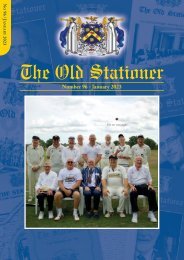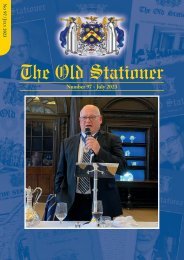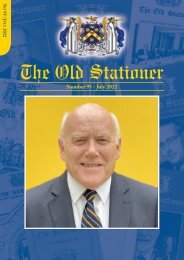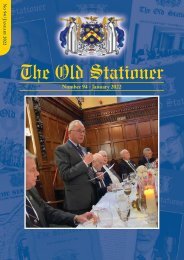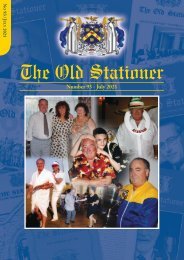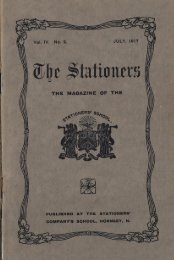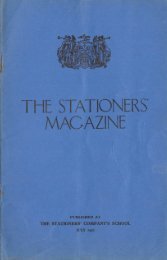You also want an ePaper? Increase the reach of your titles
YUMPU automatically turns print PDFs into web optimized ePapers that Google loves.
Snowdon excursion, partly due to the weather and partly due<br />
to a lack of height. However, chugging through the<br />
countryside, crossing over the streams, entering the woods and<br />
the little settlements along the way made for a most pleasant<br />
morning's adventure. Refreshments were served on board by<br />
one of the many volunteers who keep the trains running<br />
throughout the summer season and perform the necessary<br />
maintenance when passenger traffic ends. These volunteers<br />
are also in the process of restoring a former South African<br />
locomotive originally designed for crossing the deserts of<br />
South-West Africa and now destined for the rigours of the<br />
wet North Wales. It is due to enter service in 2015.<br />
As mentioned earlier, the town of Porthmadog owes its<br />
existence to its location between the mines and quarries of the<br />
interior and the proximity to the sea. It became, not only an<br />
export centre but also a shipbuilding hub and was renowned<br />
for a particular type of sailing vessel able to carry heavy loads<br />
of slate and negotiate the winding and shallow river which<br />
flowed into the sea. This smattering of history I picked by<br />
visiting the maritime museum in the old town. I made the<br />
mistake of asking a simple question of a rather bored looking<br />
curator who immediately came alive and subjected me to a<br />
half hour's dissertation on the qualities of Welsh slate, the<br />
detailed construction issues of ship-building and the twinges<br />
of rheumatism he was currently experiencing. The rumbling<br />
of my tummy allowed me to escape before he could tell me of<br />
his other ailments and I thankfully sought out a nearby eating<br />
establishment.<br />
I decided to return by bus which would make a pleasant<br />
change and allow me to see more of the countryside than you<br />
T h e O l d S t a t i o n e r - N o 7 5<br />
A BiG "THANK You" To JoE SYMoNS<br />
can when driving. Interestingly, they do not accept an English<br />
bus pass in Wales as, as pointed out to me by the driver, the<br />
English do not accept Welsh ones. So much for the<br />
independence movement! The journey was pleasant enough<br />
until a few miles short of our destination, the bus turned off<br />
the main road into a village and then into the bus garage. The<br />
driver had a chat with his mates, then pulled over to the fuel<br />
pump and proceeded to fill up. Mission completed, he drove<br />
out into the main road and asked us all to dismount and take<br />
the bus behind. Somewhat baffled by this procedure, although<br />
the locals took it all in their stride, I complied with his request<br />
and boarded the replacement, which soon sped away and<br />
finally delivered us back to Caernarfon. Not quite what you<br />
would expect from London Transport.<br />
All good things come to an end and I set off the next morning<br />
for the drive home. The six-hour drive gave me time to reflect<br />
on my short visit to Wales. The most striking thing for me<br />
was the wide use of the Welsh language among all generations.<br />
In my ignorance, I have always believed it was only used by<br />
older people in the more remote villages. Not so; waitresses,<br />
young shop assistants and youths in general all seemed at ease<br />
and had obviously been brought up bi-lingually. Similarly, all<br />
road signs are displayed in both languages which did make it<br />
a little difficult at busy junctions. The scenery is spectacular<br />
provided the weather is kind and there are many options<br />
available for the agile and not so agile. The natives were very<br />
friendly, even if a little garrulous, but all in all, a trip well<br />
worth taking and certainly a place to come back to.<br />
Raymond Chew<br />
In 1959 I chose Geography as one of my 3 "A" level subjects.<br />
A region of the World had to be agreed on to study for a<br />
separate section of the exam paper. I don't remember whether<br />
it was a unanimous decision but South America was chosen.<br />
After 2 years (and a pass in the exam) I had become fascinated<br />
by the jungle/rainforest of the Amazon Basin. I never really<br />
lost that feeling and desire to experience what it was really<br />
like.<br />
So, more than 50 years later, I decided to find out. An itinerary<br />
was agreed with The Real Peru Co after a few e-mails and the<br />
necessary payment made.So I set off very early on the<br />
morning of 4th June for a "holiday of a lifetime".<br />
TuESDAY<br />
There don't seem to be any direct flights to Lima from<br />
Heathrow. The options are either via anywhere in the USA or<br />
changing planes in a European capital. On the basis of cost<br />
and timings I chose to use KLM via Amsterdam, despite<br />
having to start off in the wrong direction. From Amsterdam<br />
the flight to the Peruvian capital was 12 hours, due to arrive<br />
early evening, local time. I took advantage of my window seat<br />
whilst we were crossing Brazil. The weather was clear and<br />
from 6 miles high the Amazon was easy to see. As I kept<br />
watching the Rio Negro came into view. The confluence of<br />
this dark water river joining the white water of the Amazon<br />
was amazingly clear. This was a memorab<br />
WEDNESDAY<br />
I hadn't allowed any time for sightseeing in Lima though my<br />
2 taxi journeys did use different routes. After an overnight stay<br />
and an early start I took an internal flight to Puerto<br />
Maldonado in SE Peru (after crossing the Andes). This is a<br />
small scruffy town and the last view of civilization for some<br />
days. My Star Peru flight was an hour late with no explanation<br />
as to why (as were both the later flights I had with them).<br />
There was now a short time to sort out luggage. Everyone had<br />
been asked to bring a smal1(er) bag for this part of the trip<br />
with only the clothes etc needed for the next 6 days. I had<br />
packed a bag inside a bigger bag and this worked remarkable<br />
well.<br />
There were now 16 tourists with 3 guides packed into a<br />
20-seater bus. We were driven for about Yi hour to the Rio<br />
Madre de Dios. We clambered aboard a long rowing boat<br />
with a bench seat both sides and an outboard motor at the<br />
back. With safety jackets on "the holiday starts here". The<br />
weather was sunny, temperature upper 70s and the water not<br />
too cold. Lunch of rice with vegetables, wrapped in banana<br />
leaves, was quite tasty.<br />
The journey to Refugio Lodge took 2 hours. The river was<br />
wide (wider than the Thames) with jungle on both sides.<br />
There was no other river traffic although the occasional small<br />
boat indicated indigenous peoples living nearby. Apart from a<br />
few birds the first sign of wildlife was a small group of<br />
capybara. These are the biggest rodents in the world - and as<br />
a part of the rat family you wouldn't want them any bigger<br />
(certainly pig size)!<br />
On arrival we were shown to our 3-walled rooms - the 4th<br />
33



